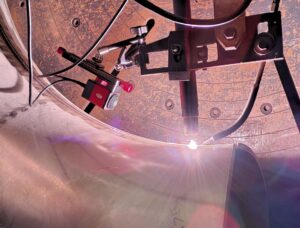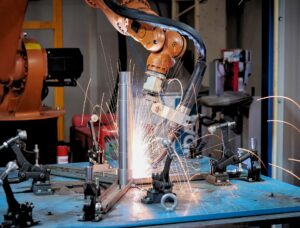Protecting people and perfecting welds—without setting foot in danger zones
In this blog, we’ll explore remote welding monitoring in hazardous environments and how camera systems enable safe, real-time quality control from dangerous locations. Welding in hazardous environments is nothing new. From nuclear containment zones to deep-sea pipelines and offshore rigs, fabricators are often required to join metal in places where heat, pressure, radiation, or toxic exposure make direct human observation dangerous—or impossible. But thanks to welding camera systems, real-time remote monitoring is not only possible—it’s becoming standard practice. These tools allow operators to see, control, and assess welds from a safe distance, without compromising on quality, precision, or safety.
What Makes an Environment “Hazardous” for Welders?
Hazardous welding zones can include areas with:
- High radiation levels (e.g., inside nuclear facilities)
- Extreme heat or pressure (e.g., furnaces or pressurized vessels)
- Toxic gases or fumes (e.g., chemical plants, confined spaces)
- Underwater or offshore conditions (e.g., pipelines, oil rigs)
- Limited access or visibility (e.g., inside tanks or narrow tunnels)
In many cases, human entry isn’t just difficult—it’s prohibited during welding operations. That’s where remote welding solutions come in.
Enter: The Welding Camera
A welding camera is designed to withstand intense arc brightness, high temperatures, and challenging conditions while capturing clear, real-time images or video of the welding process. These specialized welding cameras:
- Record video for inspection, training, and weld quality control
- Use arc filtering to cut glare and reveal weld pool behavior
- Are often mounted on robotic arms, borescopes, or fixed rigs
- Deliver live feeds to remote control rooms or mobile devices
How Welding Cameras Enable Safe Remote Monitoring
- Real-Time Arc Welding Monitoring from a Distance
Operators can view welds in real time from a control room—adjusting parameters or stopping a weld instantly if needed. - Avoiding Exposure to Dangerous Conditions
No need to suit up or risk human entry. Cameras eliminate the need for welders to be physically present in radiation zones, high-pressure tanks, or gas-filled chambers. - Monitoring Confined or Inaccessible Weld Zones
Cameras can be placed where humans can’t go—inside narrow pipe sections, deep tanks, or submerged environments—offering views that would otherwise be impossible. - Improved Operator Training and Documentation
Video footage provides a learning tool for new welders and a permanent record for audits, safety reviews, and compliance documentation. - Integration with Robotics and Automated Welding
In robotic welding applications (common in hazardous zones), cameras ensure proper positioning, tracking, and weld quality control—closing the loop for full automation.
Key Features to Look for in a Hazard-Ready Welding Camera
- High dynamic range (HDR) for arc visibility
- Thermal and environmental resistance
- Compact or flexible form factor for tight spaces
- Remote control and focus adjustments
- Wired or wireless transmission options
- Recording and data storage capabilities
Real-World Use Cases
- Nuclear Power Plants: Cameras allow weld inspection inside reactor compartments without human presence.
- Oil & Gas Rigs: Remote welding is performed on subsea pipelines and flare towers.
- Chemical Plants: Cameras prevent exposure to hazardous vapors during internal tank or pipe welding.
- Aerospace Manufacturing: Monitoring welds inside sealed assemblies and fuel tanks.
- Military/Defense Applications: Controlled welding in secure or restricted environments.
The Bottom Line: Remote Welding Monitoring in Hazardous Environments: How Cameras Make It Possible
Welding cameras have revolutionized how we approach welding in hazardous environments. By enabling precise, real-time remote monitoring, they reduce risk, increase productivity, and maintain the high quality demanded by industries where failure is not an option.
Whether you’re managing a high-risk facility, overseeing critical infrastructure, or developing advanced automated welding systems, camera-enabled remote welding is a smart, scalable solution for the future.
Explore advanced arc camera solutions for remote welding.
Contact Mecaweld today to learn how our rugged welding monitoring system can help you monitor with confidence—no matter how harsh the conditions.



